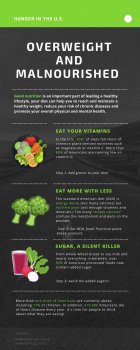The consequences of malnutrition are felt on the economy and the overall health of the population.
In the United States, malnourishment is a huge issue. According to the Global Health Corps, “About 85% of Americans do not consume the US Food and Drug Administration’s recommended daily intakes of the most important vitamins and minerals necessary for proper physical and mental development.” They added that, “More than half of American children do not get enough of vitamins D and E.” Getting food is easy, but accessing nutritious food is much more complicated. This nutritional deficiency contributes to rising health care issues around the country.

Currently, Americans are educated in calories but not in nutrients. The Standard American Diet (SAD) is energy dense (too many calories) but nutrient poor (not enough vitamins and minerals). Too many “empty calories” confuse the metabolism and contribute to weight gain. This is the main contributing factor to heart disease in America. Heart disease kills 610,000 Americans annually according to National Food & Health Statistics.

Our current education system does not provide the framework for children to learn how to become food literate. Food literacy is an understanding of the impact that your food choices have on your health, the environment, and our economy. It is expected that individuals, having received the proper food education, pay more attention to their diets. As a result of being more informed, individuals tend to put more thought and action into changing their “bad” habits.

It’s time for people to think about what they are eating!
Facts & Statistics
- 85% of Americans are nutrient deficient
- 50% of children don’t get enough Vitamin D or E
- 25% of children don’t get enough Calcium
- Elementary students get an average of 3.4 hours of food education each year
- Food education is NOT compulsory in schools nationwide
- More than 1/3 of Americans are obese – including 17% of children
Sugar – The Silent Killer
From whole wheat bread to soy milk and nearly everything in between, over 80% of American processed foods now contain added sugar. According to a Credit Suisse report in 2013, sugar can be linked to extensive health care expenses in the U.S. “30% – 40% of healthcare expenditures in the USA go to help address issues that are closely tied to the excess consumption of sugar.”
Consequences
Lack of essential nutrients in an individual’s diet is called malnutrition, the result of which is that the body will no longer function efficiently.
Common Symptoms of Malnutrition
- Reduced muscles and tissue mass
- Breathing difficulties
- Decreased mobility
- Decreased immune response
- Increased rate of chest and respiratory infections
- Poor libido, fertility problems
- Metabolic deficiency
- Increased rate of heart disease
Nutritional deficiencies and weight gain cost Americans $1 trillion per year in health care expenses.In addition to health consequences, there are also economic consequences to undernutrition. This includes the loss in productivity and wages for the sick. The overall cost of National Healthcare Expenditure is a completely avoidable drag on the economy.
The Solution
FOOD EDUCATION
In order to solve the problem of malnourishment in the U.S, American food culture needs to be disregarded and modified. Trends such as calorie counting or no-fat diets have to be abandoned. People need to turn their backs on processed foods and focus on eating REAL food. Most importantly we need to educate children about food. The value of teaching children is the possibility of lasting change on future generations. This involves knowing what to eat, where to get it and how to prepare it.





